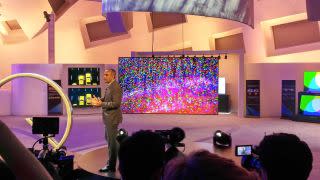New LCD TVs Offer Impressive Features and Technology

Televisions with LED/LCD-lit screens have had some obvious drawbacks—limited viewing angles, blacks that often look gray, and brightness issues that sometimes make dark scenes look cloudy.
Yet these TVs still dominate store shelves and living rooms. They vanquished plasma TVs and overwhelmingly outnumber the newer, sharper OLED TVs—both arguably superior technologies.
But LCD TV technology has steadily improved so that the best sets can now stand toe-to-toe with OLED TVs—which currently top our TV ratings in the larger screen sizes. In fact, many LCD TV "features," such as faster refresh rates and backlights with local dimming, are really techniques designed to address some of the technology's inherent shortcomings.
Here at the 2017 Consumer Electronics Show, we're getting a glimpse of the next generation of LCD technology that will move it even closer to OLED-like performance.
These new sets, from the industry giants LG and Samsung, promise to incorporate a couple of OLED's biggest strengths, most notably deep black levels and no loss of picture quality when the screen is viewed from the side.
Here are a few key developments that will debut in pricier flagship 4K models in 2017 but will likely make their way into mainstream sets in the next year or two:
Samsung Improves Quantum-Dot TVs
Samsung hit CES with some pretty impressive claims for its new line of premium Q-series TVs, which use a new metal quantum-dot material.
The company, which is marketing the new sets under the "QLED" sub-brand, says that the new quantum-dot film being used in the Q-series sets will not only produce a wider range of richer colors but also help address traditional LCD shortcomings such as grayish blacks and poor off-angle viewing.
Samsung has been using quantum dots in its top-tier TVs for a few years now, but says the Q-series sets, which replace last year's SUHD models, will outperform those models.
As a quick refresher, Samsung's quantum-dot technology uses a film embedded with tiny red and green quantum dots, or nano crystals. The film is sandwiched between the other layers of the LCD panel, directly in front of the LED backlight.
When these tiny crystals are hit with a blue light from the backlight, they glow, emitting very saturated, narrow-band primary colors, based on the size and composition of the quantum dot material. Because the size of the crystals can be controlled very precisely, the system renders very accurate colors.
What does all of that tech talk really mean? Quantum dots can help LCD TVs produce better, more vibrant colors than you get with regular LCDs.
Samsung says the new quantum-dot sets maintain their color integrity even at high levels of brightness. Increasing a TV's brightness can make colors look a bit washed out, but QLED TVs promise to display a wider range of colors at varying brightness levels with no loss in "color volume," or intensity.
In fact, the Q-series sets are as much as 50 percent brighter than last year's already-bright SUHD sets. That could mean a significant improvement in HDR (high dynamic range) performance—the difference between the darkest and brightest images a TV can produce—where peak brightness really matters.
But Samsung claims its new quantum-dot material will also improve other areas where many LCD TVs traditionally falter, such as black levels and off-angle viewing. Samsung is using a new backlight technology to produce deeper blacks and more uniform brightness across the panel, but the company declined to explain exactly how it worked.
Based on a short demo we received during a preview of the new sets, the TVs did seem to have less haloing—oddly illuminated areas around the edges of objects—as well as improved viewing angles.
LG Uses Nano Technology

LG is the current king of OLED televisions, but most of the sets it sells are LED/LCD. Like Samsung, the company is turning to nano technology with its new line of premium "Super UHD" LED/LCD TVs. LG says its "Nano Cell" technology will help to create better, more realistic colors and wider viewing angles.
Nano Cell technology is similar to, but not quite the same as, quantum dots. We'll be trying to learn a bit more about it throughout the year, but as LG explained it to us, the new Nano Cell LCD TVs use a film with uniformly sized particles, each a nanometer a wide. (For reference, a human hair measures about 80,000 to 100,000 nanometers.) That makes them even smaller than quantum dots.
LG says the technology "absorbs excess light wavelengths," meaning that it prevents adjacent colors from bleeding into each other. That's supposed to make the colors more accurate and resistant to fading.
Like Samsung, LG claims this technology improves LCD performance in other ways, especially off-axis viewing. LG TVs already offer comparatively wide viewing angles, and the nano film helps maintain picture quality when you're viewing it from a corner of the room. LG also says the TVs are brighter than last year's Super UHD models.
To take full advantage of the technology, LG has partnered with Hollywood color experts Technicolor to create a Technicolor Expert Mode setting, which is optimized for best colors and HDR.
Speaking of HDR, LG's Super UHD TVs may be the most future-proofed we've seen so far, as they support not only HDR10 and Dolby Vision HDR technologies but also a newer one called HLG, which was designed for live broadcasts, plus Technicolor's own Advanced HDR.
As always, we're looking forward to bringing these new sets from both LG and Samsung into our labs and seeing if they live up to their claims. We'll be here at CES 2017 all week, so check back for all our CES updates.
More from Consumer Reports:
Top pick tires for 2016
Best used cars for $25,000 and less
7 best mattresses for couples
Consumer Reports has no relationship with any advertisers on this website. Copyright © 2006-2017 Consumers Union of U.S.

 Yahoo Finance
Yahoo Finance 